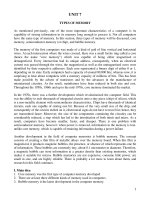Tài liệu Historical Dictionary Of Architecture doc
Bạn đang xem bản rút gọn của tài liệu. Xem và tải ngay bản đầy đủ của tài liệu tại đây (2.26 MB, 399 trang )
ALLISON LEE PALMER
HISTORICAL DICTIONARY OF
HISTORICAL
DICTIONARY
OF
PALMER
For orders and information please contact the publisher
SCARECROW PRESS, INC.
A wholly owned subsidiary of
The Rowman & Littlefield Publishing Group, Inc.
4501 Forbes Boulevard, Suite 200
Lanham, Maryland 20706
1-800-462-6420 • fax 717-794-3803
www.scarecrowpress.com
COVER IMAGE © SCPHOTOS / ALAMY
ISBN-13: 978-0-8108-5821-3
ISBN-10: 0-8108-5821-5
Historical Dictionaries of Literature and the Arts, No. 29
Architecture, which can be understood in its most basic sense as a form of
enclosure created with an aesthetic intent, first made its appearance in the
Prehistoric Age. From its earliest developments, architecture changed over
time and in different cultures in response to changing cultural needs, aesthetic
interests, materials, and techniques.
The Historical Dictionary of Architecture provides information on architects
such as Frank Lloyd Wright, Tadao Ando, Leon Battista Alberti, Filippo
Brunelleschi, Michelangelo, and Konstantin Stepanovich Melnikov, as well as
on famous structures such as the Acropolis, the Colosseum, the Forbidden
City, Machu Pichu, Notre Dame, the Pyramids of Giza, Stonehenge, and the
World Trade Center. The dictionary examines the development of architecture
over the centuries through a chronology, an introductory essay, a bibliography,
and hundreds of cross-referenced dictionary entries on the major architects,
well-known buildings, time periods, styles, building types, and materials in
world architecture.
Allison Lee Palmer is professor of art history at the University of Oklahoma.
ARTS • ARCHITECTURAL HISTORY
Architecture
Arc hitecture
HD Architecture.indd 1HD Architecture.indd 1 8/11/08 11:16:24 AM8/11/08 11:16:24 AM
Historical Dictionaries of Literature and the Arts
Jon Woronoff, Series Editor
1. Science Fiction Literature, by Brian Stableford, 2004.
2. Hong Kong Cinema, by Lisa Odham Stokes, 2007.
3. American Radio Soap Operas, by Jim Cox, 2005.
4. Japanese Traditional Theatre, by Samuel L. Leiter, 2006.
5. Fantasy Literature, by Brian Stableford, 2005.
6. Australian and New Zealand Cinema, by Albert Moran and Errol
Vieth, 2006.
7. African-American Television, by Kathleen Fearn-Banks, 2006.
8. Lesbian Literature, by Meredith Miller, 2006.
9. Scandinavian Literature and Theater, by Jan Sjåvik, 2006.
10. British Radio, by Seán Street, 2006.
11. German Theater, by William Grange, 2006.
12. African American Cinema, by S. Torriano Berry and Venise Berry,
2006.
13. Sacred Music, by Joseph P. Swain, 2006.
14. Russian Theater, by Laurence Senelick, 2007.
15. French Cinema, by Dayna Oscherwitz and MaryEllen Higgins,
2007.
16. Postmodernist Literature and Theater, by Fran Mason, 2007.
17. Irish Cinema, by Roderick Flynn and Pat Brereton, 2007.
18. Australian Radio and Television, by Albert Moran and Chris Keat-
ing, 2007.
19. Polish Cinema, by Marek Haltof, 2007.
20. Old Time Radio, by Robert C. Reinehr and Jon D. Swartz, 2008.
21. Renaissance Art, by Lilian H. Zirpolo, 2008.
22. Broadway Musical, by William A. Everett and Paul R. Laird, 2008.
23. American Theater: Modernism, by James Fisher and Felicia Hardi-
son Londré, 2008.
24. German Cinema, by Robert C. Reimer and Carol J. Reimer, 2008.
25. Horror Cinema, by Peter Hutchings, 2008.
26. Westerns in Cinema, by Paul Varner, 2008.
27. Chinese Theater, by Tan Ye, 2008.
28. Italian Cinema, by Gino Moliterno, 2008.
29. Architecture, by Allison Lee Palmer, 2008.
of Architecture
Allison Lee Palmer
Historical Dictionaries of
Literature and the Arts, No. 29
The Scarecrow Press, Inc.
Lanham, Maryland • Toronto • Plymouth, UK
2008
SCARECROW PRESS, INC.
Published in the United States of America
by Scarecrow Press, Inc.
A wholly owned subsidiary of
The Rowman & Littlefield Publishing Group, Inc.
4501 Forbes Boulevard, Suite 200, Lanham, Maryland 20706
www.scarecrowpress.com
Estover Road
Plymouth PL6 7PY
United Kingdom
Copyright © 2008 by Allison Lee Palmer
All rights reserved. No part of this publication may be reproduced,
stored in a retrieval system, or transmitted in any form or by any
means, electronic, mechanical, photocopying, recording, or otherwise,
without the prior permission of the publisher.
British Library Cataloguing in Publication Information Available
Library of Congress Cataloging-in-Publication Data
Palmer, Allison Lee, 1963–
Historical dictionary of architecture / Allison Lee Palmer.
p. cm. — (Historical dictionaries of literature and the arts ; no. 29)
Includes bibliographical references.
ISBN-13: 978-0-8108-5821-3 (cloth : alk. paper)
ISBN-10: 0-8108-5821-5 (cloth : alk. paper)
eISBN-13: 978-0-8108-6283-8
eISBN-10: 0-8108-6283-2
1. Architecture—History—Dictionaries. I. Title.
NA200.P35 2008
720.9—dc22 008013926
∞
™
The paper used in this publication meets the minimum requirements of
American National Standard for Information Sciences—Permanence of Paper
for Printed Library Materials, ANSI/NISO Z39.48-1992.
Manufactured in the United States of America.
To my father, Melvin Delmar Palmer
vii
List of Illustrations ix
Editor’s Foreword Jon Woronoff xi
Preface xiii
Acknowledgments xv
Chronology xvii
Introduction xliii
THE DICTIONARY 1
Bibliography 289
About the Author 319
ix
Note: Photographs appear in the center of the book.
1. Stonehenge, Salisbury Plain, England, c. 3100–1500 BC (Photo:
Nancy Lee Palmer)
2. Pyramids at Giza, outside Cairo, Egypt, c. 2500 BC (Photo: Dawn
St. Clare)
3. Parthenon, Acropolis, Athens, 400s BC (Photo: Dawn St. Clare)
4. Colosseum, Rome, AD 72–80 (Photo: Dawn St. Clare)
5. Pantheon, Rome, AD 128 (Photo: Dawn St. Clare)
6. Angkor Wat, Angkor, Cambodia, AD 800s–1200s (Photo: Nancy
Lee Palmer)
7. Anasazi “Great House” foundations, New Mexico, 900s–1400s
(Photo: Allison Lee Palmer)
8. Uxmal Ceremonial Center, Mexico, 800s–1200s (Photo: Dawn St.
Clare)
9. Machu Picchu, Peru, 1450s (Photo: Allison Lee Palmer)
10. Forbidden City, Beijing, 1368–1644 (Photo: Dawn St. Clare)
11. Castel del Monte, Puglia, 1240 (Photo: Allison Lee Palmer)
12. Notre Dame, Paris, 1200s (Photo: Dawn St. Clare)
13. Florence Cathedral, dome by Filippo Brunelleschi, 1420s (Photo:
Dawn St. Clare)
14. Saint Peter’s Church, Rome, begun 1505 (Photo: Dawn St. Clare)
15. Andrea Palladio, Villa Rotonda, Vicenza, Italy, 1560s (Photo:
Dawn St. Clare)
16. Louis Le Vau, Versailles Palace, Versailles, 1660s (Photo: Nancy
Lee Palmer)
17. Charles Garnier, Opéra, Paris, 1860s (Photo: Dawn St. Clare)
18. John Barry and Horace Jones, Tower Bridge, London, 1886–1894
(Photo: Allison Lee Palmer)
19. Gustav Eiffel, Eiffel Tower, Paris, 1889 (Photo: Dawn St. Clare)
20. Antoní Gaudi, Parc Güell, Barcelona, 1900s–1910s (Photo: Alli-
son Lee Palmer)
21. Frank Lloyd Wright, Robie House, Chicago, 1909 (Photo: Allison
Lee Palmer)
22. Gerrit Rietveld, Schroeder House, Utrecht, 1924 (Photo: Allison
Lee Palmer)
23. Le Corbusier, Villa Savoye, Poissy-sur-Seine, 1929 (Photo: Dawn
St. Clare)
24. Shreve, Lamb, and Harmon, Empire State Building, New York,
1930s (Photo: Dawn St. Clare)
25. Le Corbusier, Notre Dame du Haut, Ronchamp, 1955 (Photo:
Dawn St. Clare)
x•ILLUSTRATIONS
Editor’s Foreword
xi
Architecture is unquestionably one of the arts, and certainly not a lesser
one, but dealing with it purely as an art would be very incomplete. For,
more than other arts, it depends heavily on technology as concerns ma-
terials used, construction techniques, and new technological possibili-
ties in other fields. There is also a commercial aspect, as cost matters in
many—if not quite all—cases. Meanwhile, broader trends in society
and politics impinge on just what will be built, while aesthetic currents
and even fads determine what style will be adopted. Thus a multifaceted
approach is essential, one that is applied here and makes this historical
dictionary particularly useful. This being said, it starts at the beginning,
with Ancient Egyptian, Near Eastern, Greek and Roman architecture,
and others, does not forget the middle with the Gothic, Renaissance,
Baroque, and Rococo, and again others, and goes right up to Post-
Modernist and High-Tech architecture and, yet again, others. While
much of the coverage is “western,” other areas are not forgotten, such
as China, India, Japan, or Mesoamerica and, for the last time, others. So
it covers all the historical periods from the oldest to the most recent and
all the major regions of the world.
This makes the Historical Dictionary of Architecture a welcome ad-
dition to the pool of information on the subject even in this age of the
Internet when so much can be found on the Web. However, unlike the
Web, this is all written by one person who has gone out of her way to
integrate the material, so that one dictionary entry relates to another, and
there are few gaps and little duplication. This is most obvious from the
extensive dictionary section, which covers the periods and styles men-
tioned above, and the various regions, and also has entries on notable
architects, landmark buildings, technical terms, and various building
materials. The progression over time and to some extent geographically
can be traced in the chronology, which also refers readers to specific en-
tries. Meanwhile, the introduction puts architecture in its broader con-
text, and is worthwhile reading in its own right but also as a preliminary
to looking up dictionary entries. The bibliography then directs readers
to other sources of literature on the topic and even to some websites
where further information can be found.
This book was written by Allison Lee Palmer, who is an associate
professor of art history at the University of Oklahoma, a place where ar-
chitecture is particularly appreciated. There she teaches in the School of
Art, giving courses on Renaissance art through the art of the 18th cen-
tury. Obviously she has a specialization, which is Renaissance and
Baroque art, on which she has written extensively. This is quite normal
for an academic. What is less so is that she has such a broad view of ar-
chitecture that in this book she can cover the whole field competently,
a less common achievement in this age of academic specialization.
There is no doubt that an awful lot of work went into writing this his-
torical dictionary, and there is also no doubt that it fills an important gap
in this series on Literature and the Arts. It will serve as an unusually
helpful and handy guide to many students, teachers, and the general
public with an interest in one of the more unique arts.
Jon Woronoff
Series Editor
xii • EDITOR’S FOREWORD
Preface
xiii
The entries in this encyclopedia include architectural developments,
major structures, primary materials, and noted architects. By develop-
ments, I mean historical eras like the Renaissance, for example, or
movements such as Art Deco. Structures include not only major
achievements such as the Alhambra, but also diverse architectural in-
ventions including the arch and the skyscraper. Materials discussed
range from concrete to stone, and glass to wood. Noted architects in-
clude theorists from the Ancient Roman engineer Vitruvius to many
current architects like Zaha Hadid and Santiago Calatrava. Neverthe-
less, this volume is neither a history of architecture nor a comprehen-
sive cataloging of movements, architects, and their creations. Like other
encyclopedias, the organization here is alphabetical. However, unlike
encyclopedias that aim to include more comprehensive but less detailed
information, I have tried to provide more substantial commentary in
fewer entries. I have especially aimed to make the historical entries ca-
pable of standing alone and, if taken all together, of providing a suffi-
cient history of architecture for the general reader. I realize that my
method overlooks a number of extremely gifted artists and outstanding
structures. In lieu of comprehensiveness, however, I trust that the con-
texts provided in this book will enable the reader not only to identify
and examine those aspects of architecture that lie outside this volume
but also to find a richer appreciation of the basic human urge to build
both functional and beautiful structures.
xv
I would like to thank my father, Melvin Delmar Palmer, for his work in
editing my manuscript through several stages of its writing. His careful
reading took most of the summer of 2007, and his personal knowledge
of these sites ensured a careful and critical reading of the architectural
descriptions presented in this volume. My series editor, Jon Woronoff,
also provided excellent suggestions for additional buildings and entries
that improved my text. In addition, I am very grateful to both my par-
ents for giving me the opportunity to travel so extensively throughout
my childhood. Having seen the majority of these buildings firsthand
certainly influenced my decision to focus my studies on the history of
architecture. I would also like to thank my mother, Nancy Lee Palmer,
for supplying some of the photographs published in this volume. Dawn
St. Clare, who received her M.A. in art history at the University of Ok-
lahoma, also provided me with photographs from her collection of im-
ages, and her work in assembling the photographs for this publication
has been invaluable.
xvii
While the dictionary itself provides an alphabetized presentation of en-
tries, this chronology gives a framework of architectural developments
over time. Under each heading, the dictionary’s references to architects,
buildings, and relevant styles are listed in historical order. The conclud-
ing topic, Structures and Materials, lists architects and buildings that il-
lustrate the use of common architectural materials. (Bold italic type in-
dicates that the item has its own entry in the dictionary.)
ANCIENT ARCHITECTURE (EUROPE, NEAR EAST,
NORTH AFRICA) (15,000 BC–AD 400s)
Prehistoric Architecture
(Paleolithic and Neolithic)
c. 15,000 BC Mammoth-bone house, Mezhirich, Ukraine
(Paleolithic)
c. 6500 BC Çatal Hüyük, village, Turkey (Neolithic)
c. 3100 BC Skara Brae, village, Orkney Islands, Scotland
(Neolithic)
c. 3100–1500 BC Stonehenge, Salisbury Plain, Wiltshire, Eng-
land (Neolithic)
c. 3000–2500 BC Newgrange, tombs, Ireland (Neolithic)
Ancient Near Eastern Architecture
(Sumerian,
Mari, Babylonian, Assyrian, Persian)
c. 7200 BC Ain Ghazal, Jordan (Neolithic)
c. 7000 BC Jericho, walls of the city (Neolithic)
c. 6500 BC Çatal Hüyük, Turkey (Neolithic)
c. 2100 BC Nanna Ziggurat, Ur, Iraq (Sumerian)
2000s BC Palace of Zimrilim, Syria (Mari)
late 900s BC–AD 70 Temple of Solomon, Jerusalem (Jewish)
c. 720 BC Citadel of Sargon II, modern-day Khorsabad,
Iraq (Assyrian)
c. 575 BC Ishtar Gate and throne room (Neo-Babylonian)
c. 518–460 BC Palace of Darius at Persepolis, Iran (Persian)
Ancient Egyptian Architecture
c. 2665 BC King Djoser’s funerary complex, Saqqara
c. 2589–2503 BC Pyramids of Giza, Egypt
c. 2100 BC Model from Tomb of Meketra, Thebes
1473–1458 BC Temple of Queen Hatshepsut, Deir el-Bahri
c. 1295–1186 BC Great Temple of Amun, Karnak
c. 1279 BC Temple of Amun, Mut and Khonsu, Luxor
c. 1279 BC Temple of Rameses II and Temple of Nefertari,
Abu Simbel
Ancient Aegean Architecture
(Minoan and Mycenaean)
c. 1900–1400 BC Palace at Knossos, Crete (Minoan)
c. 1600–1200 BC Citadel at Mycenae, Greece (Mycenaean)
c. 1300 BC Citadel at Tiryns, Greece (Mycenaean)
Ancient Greek Architecture
c. 550 BC Temple of Hera I, Paestum, Italy
c. 530 BC Treasury of the Siphnians, Delphi
500s BC Sanctuary of Apollo, Delphi
mid-400s BC Acropolis, Athens
c. 400 BC Athenian Agora, Athens
c. 400 BC Temple of Athena Pronaia, Delphi
300s BC Miletos, city plan, modern-day Turkey
c. 200 BC Theater at Epidauros
AD 132 Temple of the Olympian Zeus, Athens
xviii • CHRONOLOGY
Etruscan Architecture
480 BC Tomb of the Lioness, Tarquinia
200s BC Tomb of the Reliefs, Cerveteri
c. 100s BC Porta Augusta, Perugia
Ancient Roman Architecture
late 100s BC Pont du Gard, Nîmes, France
late 100s BC Temple of Portunus, Rome
13 BC Ara Pacis, Rome
AD 72–80 Colosseum, Rome
AD 79 Pompeii, city plan
AD 81 Arch of Titus, Rome
AD 100s Timgad, Algeria
AD 113 Basilica Ulpia, Rome
AD 113 Column of Trajan, Rome
c. AD 125 Hadrian’s Villa, Tivoli
AD 118–125 Pantheon, Rome
AD 200s Hadrian’s Wall, Great Britain
AD 211 Baths of Caracalla, Rome
AD 300s Roman Forum, Rome
AD 310 Basilica of Maxentius and Constantine, Rome
AD 315 Arch of Constantine, Rome
Vitruvius Pollio, Marcus (c. 80–25 BC)
Early Semitic and Christian Architecture
AD 240s House-Church, Dura-Europos, Syria
AD 320s Saint Peter’s Church, Rome
AD 350s Santa Costanza, Rome
CHRONOLOGY • xix
AD 420s Santa Sabina, Rome
AD 425 Mausoleum of Galla Placidia, Ravenna
ARCHITECTURE OF ASIA
Indian Architecture
(and Pakistan,
Afghanistan, Nepal, Bangladesh, Sri Lanka)
c. 2600 BC Mohenjo-Daro
200s BC Ajanta Caves, Deccan
200s–100s BC Great Stupa, Sanchi
100s BC Rock-Cut Hall of Karla
c. AD 530 Vishnu Temple at Deogarh
c. 1000 Kandariya Mahadeva Temple, Khajuraho,
Madhya Pradesh, India
c. 1000 Rajarajeshvara Temple to Shiva, Thanjavur,
Tamil Nadu, India
1057–1287 Bagan, temple complex, Myanmar
1632–1648 Taj Mahal, Agra, Mughal Empire
Chinese Architecture
AD 618–907 Chang’an, Capital of Tang Dynasty
AD 645 Great Wild Goose Pagoda at Ci’en Temple,
Xi’an, Shanxi Province, Tang Dynasty (rebuilt
700s)
AD 782 Nanchan Temple, Wutaishan, Shanxi Province.
Tang Dynasty
1368–1644 Forbidden City, Beijing, Ming Dynasty
Foster, Norman (1935– ): 1986, Hongkong and Shanghai Bank, Hong
Kong
Pei, I. M. (1917– ): 1980s, Bank of China, Hong Kong
Skidmore, Owings & Merrill: 1998, Jin Mao Building, Shanghai
Japanese Architecture
early AD 100s Ise, Inner Shrine, Mie Prefecture, Yayoi Period
(rebuilt 1993)
xx • CHRONOLOGY
600s Horyu-ji, Main Compound, Nara Prefecture,
Asuka Period
c. 1053 Byodo-in, Uji, Kyoto Prefecture, Heian Period
early 1600s Katsura Palace, Kyoto, by Kobori Enshu
1600s Himeji Castle, Hyogo, near Osaka, Momoyama
Period
Tange, Kenzo (1913–2005): 1964, Yoyogi Gymnasium, Tokyo
Olympics
Ando, Tadao (1941– ): 1976, Azuma House, Osaka; 1988, Church on
the Water, Tomamu; 1989, Church of the Light, Ibaraki-shi, Osaka
Ito, Toyo (1941– ): 1984, Silver Hut, Tokyo
Southeast Asian Architecture (Myanmar [Burma], Malaysia,
Singapore, Indonesia, Thailand, Taiwan, Laos, Cambodia,
Vietnam, etc.).
See Indian Architecture
1100s Angkor, Cambodia, begun
PRE-COLUMBIAN ARCHITECTURE
OF THE AMERICAS (900s BC–AD 1500s)
Mesoamerican Architecture
(Aztec, Inca,
Maya, Olmec, Teotihuacan, Zapotec)
c. 900–600 BC La Venta, Great Pyramid and Ballcourt, Mexico
(Olmec)
c. 500 BC Teotihuacan, ceremonial center, Mexico
AD 400s–700s Tikal ceremonial center, Guatemala (Maya)
800s–1200s Chichen Itza, Yucatan, Mexico (Maya)
1200s–1500s Tenochtitlan, Great Pyramid, Mexico City
(Aztec)
1450–1530 Machu Picchu, Peru
Native American Architecture
(North and South America)
900s–1400s Anasazi “Great Houses,” New Mexico, Utah,
Arizona, and Colorado
900s–1400s Chaco Canyon, New Mexico
CHRONOLOGY • xxi
c. 1150 Cahokia, East St. Louis, Missouri
1450s Pueblos at Taos, New Mexico
MEDIEVAL ARCHITECTURE (400s–1300s)
Byzantine Architecture
530s Hagia Sophia, by Anthemius of Tralles and
Isidorus of Miletus, Istanbul
AD 546 San Vitale, Ravenna, Italy
early 1000s Monastery of Hosios Loukas, near Stiris,
Greece
c. 1017 Cathedral of Santa Sophia, Kiev, Ukraine
1063 Cathedral of San Marco, Venice, Italy
Islamic Architecture
(Moorish, Mughal, Ottoman, Seljuk)
692 Dome of the Rock, Jerusalem, begun
740s Mshatta Palace, Jordan, begun
785 Great Mosque, Cordoba, Spain
847 Great Mosque, Samarra
1350s Alhambra, Granada, Spain
1570s Sinan, Selimiye Mosque, Edirne, Turkey
1632–1648 Taj Mahal, Agra, India (Mughal Empire)
1980s King Faisal Mosque, Islamabad, Pakistan
1986–1993 King Hassan II Mosque, Casablanca, Morocco
Sinan, Mimar Koca Agha (1489–1588): 1550s, Süleyman Mosque,
Istanbul
Early Medieval Architecture
(Carolingian and Ottonian)
529 Monastery of Montecassino, Italy
late 600s Santa Maria de Quintanilla de las Viñas, Bur-
gos, Spain
792–805 Palace Complex of Charlemagne, Aachen, Ger-
many (Carolingian)
xxii • CHRONOLOGY
799 Abbey Church of St. Riquier, Monastery of
Centula, France (Carolingian), dedicated
c. 817 Saint Gall Monastery (Carolingian)
961 Church of Saint Cyriakus, Gernrode, Germany
(Ottonian), begun
1001–1032 Church of Saint Michael, Hildesheim, Ger-
many (Ottonian)
Romanesque Architecture
; see also
Castle
1030s Krak des Chevaliers, Syria, begun
1060s Pisa Cathedral Complex, Italy
c. 1060s Saint-Étienne, Caen, Normandy, France
c. 1075–1100s Durham Castle and Cathedral, England
1078 Tower of London, London, begun
1078–1122 Cathedral of Saint James, Santiago de Com-
postela, Spain
1080 Sant’Ambrogio, Milan
1130s Saint-Lazare, Autun
1130s Cathedral of Saint-Lazare, Autun, begun
1240s Castel del Monte, region of Puglia
Gothic Architecture
c. 1130s Chartres Cathedral, Chartres, France
1160s Notre Dame, Paris
1211 Reims Cathedral, Reims, France, begun
1240s Sainte-Chapelle, Paris, France
1240s Cologne Cathedral, Cologne, Germany
1250s Amiens Cathedral, Amiens, France
1300s Milan Cathedral, Milan, Italy
PRE-MODERN ARCHITECTURE IN EUROPE (1400s–1700s)
Renaissance Architecture
1290s Florence Cathedral, Italy, begun
1290s Palazzo della Signoria, Florence, 1290s
CHRONOLOGY • xxiii
1505 Saint Peter’s Church, Rome, begun
1520s Fontainebleau, France, begun
1530s–2000s Louvre, Paris
1559 Escorial, Madrid, begun
Brunelleschi, Filippo (c. 1377–1446): 1420s, Florence Cathedral
Dome, Italy; 1420s, Ospedale degli Innocenti (Foundling Hospital),
Florence; 1420s, San Lorenzo, Florence; 1430s, Santo Spirito, Flo-
rence; 1430s, Pazzi Chapel, Florence
Michelozzo di Bartolomeo (1391– c. 1472): 1440s, Medici Palace, Flo-
rence
Alberti, Leon Battista (1404–1472): 1450s, Tempio Malatestiano, Rim-
ini; 1470, Sant’Andrea, Mantua
Sangallo, Giuliano da (c. 1443–1516): 1480s, Villa Medici at Poggio a
Caiano, outside Florence; 1485, Santa Maria delle Carceri, Prato,
Italy
Bramante, Donato (1444–1514): 1501, Tempietto; 1505–1513, Saint
Peter’s Church, Rome
Serlio, Sebastiano (1475–1554)
Michelangelo Buonarroti (1475–1564): 1520s, façade, San Lorenzo,
Florence; 1530s–1540s, Capitoline Hill, Rome; 1530s–1560s, Saint
Peter’s Church, Rome
Raphael Sanzio (1483–1520): 1510s, Villa Madama, Rome
Sangallo, Antonio da the Younger (1484–1546): 1530s, Farnese Palace,
Rome
Sansovino, Jacopo (1486–1570): 1520s, Library, Venice
Palladio, Andrea (1508–1580): 1560s, Villa Rotunda; Vicenza, Italy;
1560s–1570s, San Giorgio Maggiore, Venice, 1560s–1570s;
1580–1585, Teatro Olimpico (with Vincenzo Scamozzi), Vicenza
Mannerism
Michelangelo Buonarroti (1475–1564): 1520s, Laurentian Stairs, Flo-
rence; 1520s, New Sacristy, San Lorenzo, Florence
Peruzzi, Baldassare (1481–1537): 1534, Palazzo Massimo alle
Colonne, Rome
Romano, Giulio (c. 1499–1546): 1520s, Palazzo del Tè, Mantua
xxiv • CHRONOLOGY









